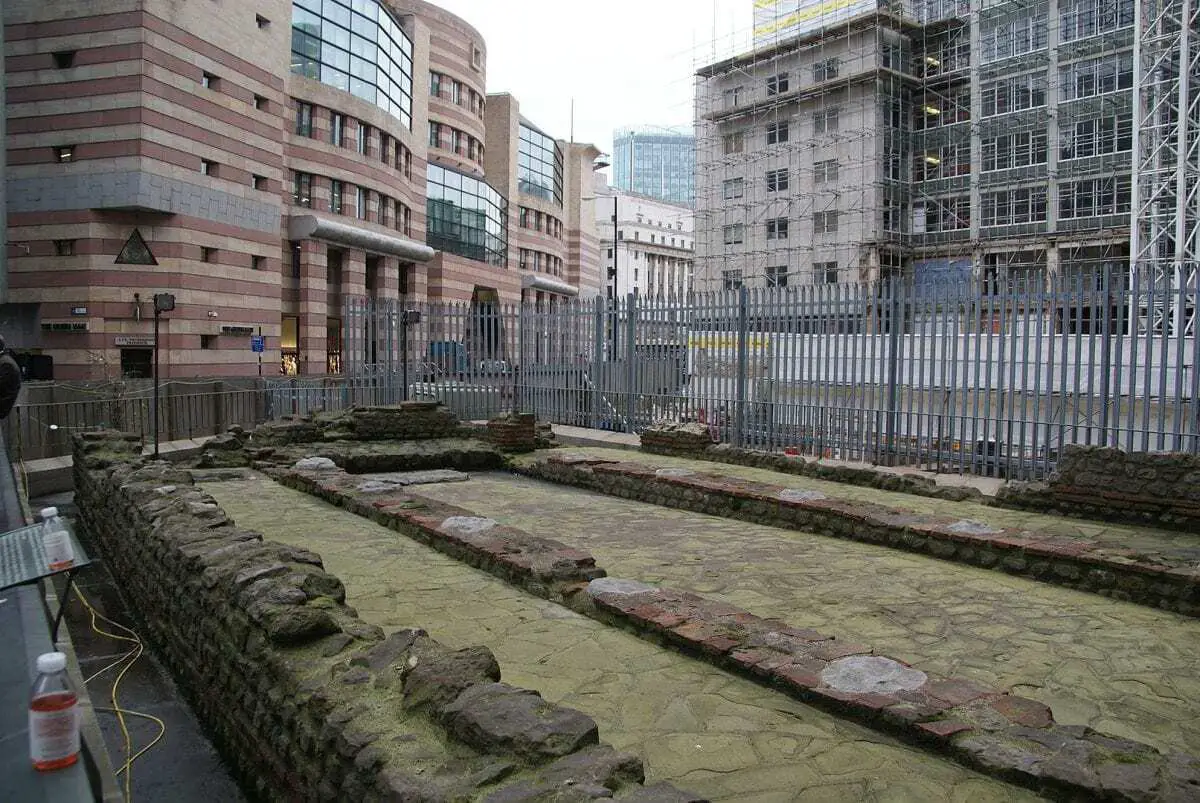Plans to dismantle and move the reconstructed Roman Temple of Mithras to temporary storage, ahead of a more faithful reconstruction, will begin on the 21 November 2011 by Museum of London Archaeology.
The temple, which is located at Walbrook Square, was discovered by chance in 1952 by archaeologist WF Grimes as the site was being prepared for redevelopment. On the last day of excavation, 18 September 1954, the marble head of the god of Mithras was unearthed. Several more amazing artefacts, including several sculptures, were later found – these are now on display in the Museum of London’s Roman gallery.
The temple was dismantled at that time and the Roman building material put into storage. In 1962, the temple was reconstructed on a podium adjacent to Queen Victoria Street, 90 metres from its original site, nine metres above its original level and set in modern cement mortar.
In December 2010, Bloomberg LP, the global business and financial information and news leader, purchased the Walbrook Square site to build its new European headquarters building. Listed building consent was granted for the dismantling of the current Temple of Mithras reconstruction and expert stone masons have been commissioned by Bloomberg to carefully extract the Roman stone and tile from the 1960s cement mortar. The temple is due to be carefully packaged up and moved to storage for the second time.
Bloomberg LP will restore the temple to its original Roman location and a more historically accurate guise. Upon completion of Bloomberg’s new development, the new reconstruction of the Temple of Mithras will be housed in a purpose-built and publicly accessible interpretation space within their new building.
Background:
The Temple of Mithras, Walbrook is a Roman temple whose ruins were discovered in Walbrook, a street in the City of London, during rebuilding work in 1954. It is perhaps the most famous of all twentieth-century Roman discoveries in the City of London.
The site was excavated by W. F. Grimes, director of the Museum of London in 1954. The temple, initially hoped to have been an early Christian church, was built in the mid-3rd century and dedicated to Mithras or perhaps jointly to several deities popular among Roman soldiers. Then it was rededicated, probably to Bacchus, in the early fourth century.
Found within the temple, where they had been carefully buried at the time of its rededication, were finely detailed third-century white marble likenesses of Minerva, Mercury the guide of the souls of the dead, and the syncretic gods Mithras and Serapis, imported from Italy.
There were several coarser locally-made clay figurines of Venus, combing her hair. The artefacts recovered were put on display in the Museum of London.
Among the sculptures the archaeologists found was a head of Mithras himself, recognizable from his Phrygian cap. The base of the head is tapered to fit a torso, which was not preserved.
In 1889, artefacts were found in Walbrook; they probably came from the Mithraeum, though it was not identified at the time (Merrifield 1965, p.179). One of these was a marble relief, 0.53 m, of Mithras in the act of killing the astral bull, the Tauroctony that was as central to Mithraism as the Crucifixion is to Christianity.
On it Mithras is accompanied by the two small figures of the torch-bearing celestial twins of Light and Darkness, Cautes and Cautopates, within the cosmic annual wheel of the zodiac. At the top left, outside the wheel, Sol–Helios ascends the heavens in his biga; at top right Luna descends in her chariot. The heads of two wind-gods, Boreas and Zephyros, are in the bottom corners. It bears the inscription
VLPIVS SILVANVS EMERITVS LEG II AVG VOTVM SOLVIT FACTVS ARAVSIONE
which may be translated “Ulpius Silvanus, veteran soldier of the Second Augustan Legion, in fulfillment of a vow, makes this altar [as the result of] a vision” or “Ulpius Silvanus, veteran of the Second Legion Augusta, fulfilled his vow having become (a Mithraist) at Orange” [University of Edinburgh, Classics Department, teaching collection] (Collingwood and Wright 1965, No. 3). Nearby were buried heads of the Roman goddess Minerva and a finely detailed bearded head of Serapis, Jupiter-like in his features but securely recognizable by the grain-basket, the modius, upon his head, a token of resurrection.
An inscription dateable AD 307–310 at the site
PRO SALVTE D N CCCC ET NOB CAES DEO MITHRAE ET SOLI INVICTO AB ORIENTE AD OCCIDENTEM
may be translated “For the Salvation of our lords the four emperors and the noble Caesar, and to the god Mithras, the Invincible Sun from the east to the west” (Collingwood and Wright 1965, no. 4).
The Roman temple, when it was originally built, would have stood on the east bank of the now covered-over River Walbrook, a key freshwater source in Roman Londinium. Nearby, in its former streambed, a small square hammered lead sheet was found, on which an enemy of someone named Martia Martina had inscribed her name backwards and thrown the token into the stream, in a traditional Celtic way of reaching the gods that has preserved metal tokens in rivers throughout Celtic Europe, from the swords at La Tène to Roman times. (Compare wishing well.)
Due to the necessity of building over the site, the whole site was uprooted and moved down the road to Temple Court, Queen Victoria Street, London EC4, where the remains of the temple foundations have been reassembled for display to the public.
Though the present location is at grade, the original Mithraeum was built partly underground, recalling the cave of Mithras where the Mithraic epiphany took place.
The temple foundations are very close to other important sites in the city of London including the historic London Stone, the Bank of England and London Wall.
Museum of London
Header Image Credit : Bill Boaden





